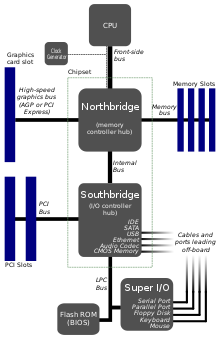Chipset

A chipset is generally used to describe several integrated circuits that belong together and that together perform a specific task. Usually it does not make sense to only use individual chips from the entirety of a chipset. There are usually only technical reasons against accommodating all functionality on one chip - for example, restrictions on the complexity of a chip, the number of connections in a chip housing or different requirements of individual circuit parts that can be implemented using different semiconductor processes or materials (e.g. B. RF signal processing with gallium arsenide and baseband processing with silicon ).
PC chipset
Specifically, the chipset on a PC - motherboard meant one microprocessor supported in his task. The reason for the division into several circuits is the number of electrical connections required.
history

In early home computers and personal computers (around 1970s to mid-1980s), the system typically consists of the microprocessor and a series of independent interface chips, all of which are addressed directly by the processor via the address, data and control bus ; an address decoder selects the relevant chip. As the level of integration progressed, more and more of these distributed functions were combined in larger chips. In the process, certain quasi-standards emerged.
The first chipset for the IBM PC / AT was the NEAT chipset for the Intel 80286 . Today, chipsets usually consist of the two-bridge architecture introduced by Intel in the 1990s , consisting of northbridge and southbridge . The names are derived from the usual location of the chips on a motherboard. The Northbridge is located (for vertical installation of the board, as in tower housings usual) mostly in the upper half of the board, so in the "North" ( Engl. "North" ), while the Southbridge is usually installed below, that in the "South" ( English "south" ). The two chips are used to control and transfer data between the individual components of the motherboard and the peripheral devices. As a rule, the northbridge microchip is used to implement interfaces with a larger bandwidth ; the southbridge, on the other hand, integrates the slower peripheral interfaces. North and south bridges were initially connected via PCI . When its bandwidth was no longer sufficient to serve the multitude of peripheral interfaces now integrated into the Southbridge sufficiently quickly, the manufacturers introduced proprietary interconnects. Examples of this are Intel's Hub Interface , VIA's V-Link and the MuTIOL Interconnect developed by SiS .
The distribution of the functionalities between the two partial chips Northbridge and Southbridge varies slightly from manufacturer to manufacturer. In the course of the ongoing miniaturization, the division into two chips has recently been canceled, see Southbridge . More and more manufacturers are offering "one-chip chipsets".
The only major manufacturers of chipsets for x86- compatible architectures today are Intel and AMD . In the past, VIA Technologies , Nvidia , SiS , ULi , ALi , ATI , Broadcom (for server computers), UMC , Symphony Laboratories , Texas Instruments , VLSI Technology and Chips & Technologies were also involved.
Chipset of the Commodore Amiga
The Amiga computer from Commodore is based on a proprietary chipset. Here it is primarily the graphics and sound output that are given priority. The Amiga chipset was split into three chips in the early 1980s due to the limited production possibilities, but it can be seen as a unit. As a result, the technical documentation often only speaks of the chipset without mentioning the individual chips. The chipset is based on a DMA unit that supplies the rest with graphics and audio data, as well as other external interfaces that were common at the time . For details see the article Original Chip Set .
Chipset of the Atari ST
The chipset of the Atari ST computer from Atari originally consisted of four chips, the so-called custom chips. These are: DMA, Shifter, MMU and Glue. The blitter was added later as an additional chip.
Web links
- Chipset in the electronics compendium
- Lecture architecture of chipsets (IBM-PC) by Sebastian Lüth and Thiemo Mättig, presented on May 22, 2001
